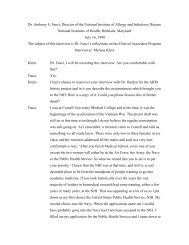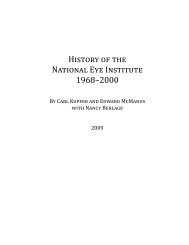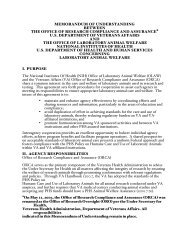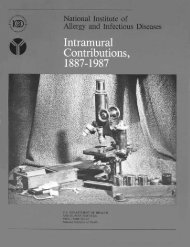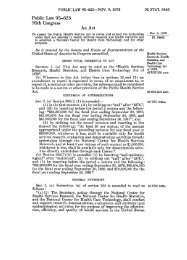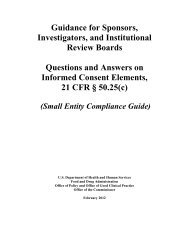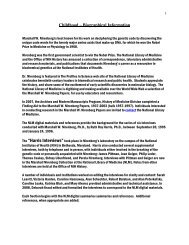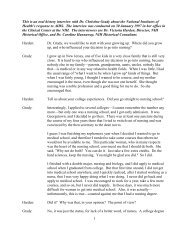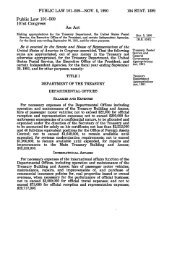Radium and the Origins of the National Cancer Institute
Radium and the Origins of the National Cancer Institute
Radium and the Origins of the National Cancer Institute
Create successful ePaper yourself
Turn your PDF publications into a flip-book with our unique Google optimized e-Paper software.
R a d i u m a n d t h e N CI105The burgeoning numbers <strong>of</strong> cancer clinics <strong>and</strong> services challengedopposition to <strong>the</strong> federal purchase <strong>of</strong> radium. With <strong>the</strong>ir budgets strainedby hard economic times, many hospitals <strong>and</strong> state health departmentsfound it very difficult to find <strong>the</strong> money for radium for such clinics, <strong>and</strong>so found <strong>the</strong>mselves unable to compete in <strong>the</strong> frenetic market for <strong>the</strong>substance. Yet dem<strong>and</strong> for radium continued to rise, fed by variouseducation campaigns that informed <strong>the</strong> public that <strong>the</strong> only cure forcancer was early treatment by radium, X-rays, <strong>and</strong> surgery undertaken bya recognized physician. 38 In <strong>the</strong>se circumstances it was <strong>of</strong>ten unclearwhat hospitals or state health departments should do to obtain radium.Occasionally, <strong>the</strong>y began anti-cancer programs even in <strong>the</strong> absence <strong>of</strong>radium, perhaps in part to create political pressure for <strong>the</strong> substance. 39But such strategies were risky. The pressure might not work, <strong>and</strong> patientswould be left with nowhere to go, except perhaps to inexperienced physicians<strong>and</strong> quacks. Thus physicians were <strong>of</strong>ten reluctant to undertakecampaigns until radium was available. 40 It was a double-bind: <strong>the</strong> absence<strong>of</strong> radium created pressure for campaigns to boost supplies, but <strong>the</strong>campaign could backfire <strong>and</strong> create dem<strong>and</strong>s that cancer programscould not meet.Against this backdrop <strong>of</strong> growing anxieties about radium, <strong>and</strong> with<strong>the</strong> Belgian war-debt repayment scheme seemingly dead, Congressrevisited plans for a cancer bill to authorize federal support for research<strong>and</strong> treatment. The Public Health Service had supported a smallresearch program on cancer since August 1922, when <strong>the</strong> SurgeonGeneral had assigned Joseph W. Schereschewsky to study <strong>the</strong> disease ina rented laboratory in <strong>the</strong> Department <strong>of</strong> Preventive Medicine at HarvardMedical School. But efforts to exp<strong>and</strong> PHS support for research hadfaltered, <strong>and</strong> bills introduced into Congress in 1927, 1928, 1929 <strong>and</strong>1930, did not pass into law. 41 Part <strong>of</strong> <strong>the</strong> reason for this failure was a lack<strong>of</strong> enthusiasm on <strong>the</strong> part <strong>of</strong> <strong>the</strong> PHS. This attitude changed with <strong>the</strong>appointment in 1936 <strong>of</strong> Thomas Parran as Surgeon General. As JamesPatterson notes, Parran had a particular interest in cancer: his wifehad died <strong>of</strong> <strong>the</strong> disease, he had served on <strong>the</strong> ASCC, <strong>and</strong> he had a liberal,activist view <strong>of</strong> <strong>the</strong> government’s role in public health. 42 The followingyear, Senator Homer Bone <strong>of</strong> Washington <strong>and</strong> Representatives MauryMaverick <strong>of</strong> Texas <strong>and</strong> Warren G. Magnuson <strong>of</strong> Washington, all




